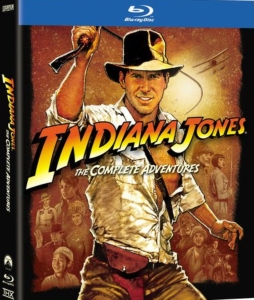My 11-day stretch without cable or Internet as I moved into a new apartment presented a perfect opportunity for an “Indiana Jones” quadrilogy rewatch on DVD. Although “Star Wars” is of course my No. 1 Lucasfilm franchise, I’ve always admired the fedora-wearing archaeologist and his world-hopping adventures as well.
Like “Star Wars,” Indy is in the process of being relaunched by Disney, which purchased Lucasfilm in 2012. While we’ve heard rumors of Chris Pratt taking over the role – made famous by Harrison Ford, and also played by Sean Patrick Flannery in “The Young Indiana Jones Chronicles” TV series (which I have never seen) – Disney is focusing on “Star Wars” before it delves heavily into “Indy.”
So while I’ve found the Mouse House’s reinvention of “Star Wars” abrupt and jarring, I’ll have time to adjust to its relaunch of “Indiana Jones.” And what’s more, “Indy” – unlike “Star Wars,” which was doing just fine before Disney rebooted the continuity – arguably is due for a relaunch. I’m not voting for rebooting the continuity, mind you, but with Ford being 73 years old — and even Flannery being 49 – it’s undeniable that the title character will have to be recast if we want to see him in his prime.
Conveniently, two important chunks of Indy’s life haven’t yet been chronicled on screen (although I imagine the comics have tackled them):
- The 1920s, between the “Young Indiana Jones” series and the first film chronologically, “Temple of Doom,” including Indy’s first encounter with Marion Ravenwood, as referenced in “Raiders of the Lost Ark,” and
- the 1940s, between “The Last Crusade” and “Kingdom of the Crystal Skull,” including Indy’s experiences during World War II, as hinted at in “Crystal Skull.”
“Kingdom of the Crystal Skull” also hinted at the idea of Indy’s son, Mutt Williams (Shia LaBeouf), taking over as the main character in future movies. It hedged its bets: In the final scene, Mutt reaches for the fedora, but Indy snatches it away. Mutt then grabs his leather jacket; he is his own man, with his own iconography appropriate to the late 1950s. “Indy” die-hards will also note that Mutt is never mentioned by Old Indy in the framing scenes of “Chronicles” (whereas Indy’s daughter, unmentioned in the films, is referenced on the TV show), which would be odd if Mutt ended up following in Indy’s footsteps. And let’s face it: “The Adventures of Mutt Williams” doesn’t have the same ring to it. Such a concept would also be limited to adventures in the 1960s and beyond.
A Pratt-fronted “Indy” franchise could fill in those aforementioned gaps in the 1920s and ’40s. Currently 36 years old, Pratt could do some movies set before the original trilogy and then some movies set between “Crusade” and “Skull.” Considering the anthology nature of the series, I don’t think a reboot would be necessary. Disney might even want to borrow the TV show’s framing mechanism (part of the original airings, but not the DVD releases, for unknown reasons) and cast Ford as Old Indy. (Ford actually did play that role in one “Chronicles” episode, although the late George Hall usually handled it).
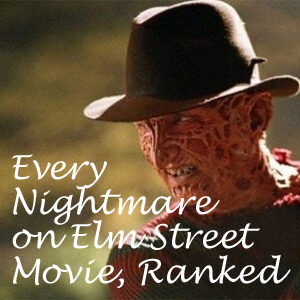
At any rate, it seems the George Lucas/Steven Spielberg “Indy” saga has come to an end, so it’s a good time to reflect on the quadrilogy:
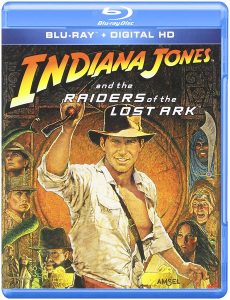
“Raiders of the Lost Ark” (1981)
I’m not going to try to argue that “Raiders” is overrated or that it’s not a classic, but the fact that the 8.6 rating on IMDB is the highest of the four films does make me think it benefits from a healthy dose of “the film that started it all” bias. I understand the plot: Indy and the Nazis both seek the Ark of the Covenant, and they intersect paths on the quest, with the Nazis sometimes letting Indy do the hard work. But the details never made sense to me, and I just accept “Raiders” as a series of great action scenes confusingly knitted together.
Released the year after “The Empire Strikes Back” came out, “Raiders’ ” Indy-Marion romance smacks heavily of Han-and-Leia (Marion even unnecessarily dons a white dress that calls to mind Leia’s princess wardrobe), and the fact that a climactic showdown occurs in the same valley where the Jawas captured R2-D2 further emphasizes the “Star Wars” parallel. The “Indy” franchise has always suffered from second-fiddle status; this is largely unfair, but it also brought it upon itself. That having been said, I have no qualms with Ford playing a second iconic hero. Usually I don’t like one actor playing multiple icons, but Han Solo/Indiana Jones is my glaring exception.
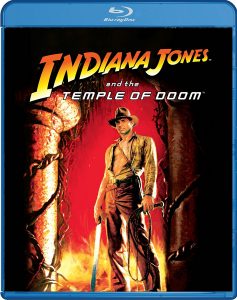
“Indiana Jones and the Temple of Doom” (1984)
While Spielberg overstates things on the DVD features by saying people hated “Temple of Doom,” the 7.6 rating on IMDB does indeed prove that this prequel is less well-liked than “Raiders.” I think it’s superior: The plot is tighter; the settings are more distanced from “Star Wars” (notably the iconic underground temple with its oranges and reds); and the chemistry between Indy (effectively played with more brash youthfulness by Ford), Willie and Short Round is excellent. (The one glaring flaw of the film is: How does Indy recover his wits after drinking the cursed blood? The writers apparently never found a good answer.)
The action sequences are the best of the series. Obviously, the mineshaft chase comes to mind first, but I also think the showdown on the collapsed bridge is incredible, complete with crocodiles chowing down on hapless Thuggees. “Not funny,” as Short Round says, but definitely fun for a viewer. And despite “Temple’s” reputation as a dark movie, there’s lots of humor, such as when Indy seeks water to soothe his burning foot only to be greeted by a roaring tunnel of H2O.
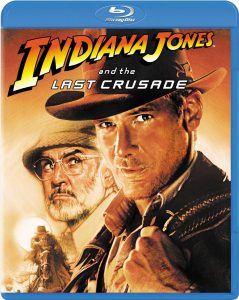
“Indiana Jones and the Last Crusade” (1989)
“Temple” fit with Lucas’ and Spielberg’s original aim of making “Indy” an anthology series. But in “Last Crusade” – either responding to fans’ criticisms of “Temple” or to their own whims – they abandon that idea and embrace more continuity. John Rhys-Davies’ Sallah returns from “Raiders” as Indy’s friend, and most notably, we learn a whole lot about Indy’s character, from small things (he got his chin scar by mishandling a whip on his first try) to big things (he followed in his father’s footsteps as a lover of artifacts, but distanced himself by being an adventurer).
With an 8.3 IMDB rating, it’s clear that fans liked the new focus on character, and even though I argue for more anthology chapters with whoever Disney chooses as the next Indy, I love “Last Crusade” too. It’s one of the best father-son movies ever made, even though Ford and Sean Connery are only 12 years apart in age. I find the idea that Indy is the cinematic son of James Bond to be overstated (archaeology, history and mysticism aren’t part of the Bond films), but there’s no doubt that these two icons have natural chemistry. “Last Crusade” is deliciously funny without losing its edge: I like how Indy regularly glances at his dad for approval after dispatching a Nazi in amazing fashion, only to be continually rebuffed.

“Indiana Jones and the Kingdom of the Crystal Skull” (2008)
If “Raiders” benefits from “Hey, it’s the original” bias, “Skull” is hurt by the curse of expectations built up during 19 years between parts three and four. It rates a mere 6.2 on IMDB. Perhaps that number will rise as time goes by, because this is a faithful continuation of the series. “Skull” acknowledges the elephant in the room – that Ford and Indy are past their world-hopping prime (if still in darn good shape for their age) – with a few old-age jokes from LaBeouf’s Mutt, but then gets on with the adventuring. The return of Marion is blatant fan service, but the actors still have great chemistry.
The killer ants are perhaps the best gross-out creatures of the saga; I love the shot of that one Russian baddie being devoured by the swarm. The humor is ever-present – turning into his dad, Indy finds Mutt’s antics “intolerable,” and I laugh out loud when Mutt uses a snake to pull Indy out of the quicksand. The chase through the jungles is epic, and while I found the three waterfalls to be too much when I saw the film in theaters, I was OK with it on this rewatch. The “nuke the fridge” scene never bothered me for some reason. Many people felt that with “Skull,” the “Indiana Jones” series crossed the line from wild adventure to stupid implausibility. For me, it toed the line but didn’t cross it.
In a somewhat unusual opinion, I rank the films thusly: “Temple of Doom,” “Last Crusade,” “Kingdom of the Crystal Skull,” “Raiders of the Lost Ark.” But I think we can all agree that Disney and perhaps Chris Pratt have their work cut out for them if they want to maintain the standard set by Ford, Lucas and Spielberg.

